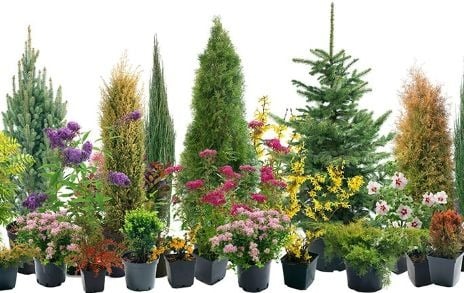February is the gateway to spring so it’s the perfect time to plant sensational spring shrubs. What’s great about shrubs in the garden is that they can provide a scattering of colour to our beds and borders whilst supporting garden wildlife too. So get planting now to turn shabby spaces to shrubby ones in no time!
What is a shrub?
A ‘shrub’ refers to woody vegetation without a trunk that has broad leaves, branching out close to the ground. They’re usually fairly hardy but typically thrive in sunny spots. Seen as the backdrop to our gardens, shrubs have many uses because they come in a variety of forms.
You’ll even find shrub varieties that climb, some fragrant with flowers, many adorned with beautiful berries and others exhibiting coloured stems. Their foliage creates a structural framework to our gardens and, when peppered in among trees, they add shape to our outdoor spaces.

A variety of uses
Deciduous shrubs shed their leaves annually and are likely to need some light pruning to shepherd new growth into place. These shrubs will gift your garden with seasonal transformations from catkins, stems, flowers and berries as the year moves along.

Turn to evergreen shrubs for year-round coverage as they don’t shed their leaves, remaining ‘ever’ green—even in the depths of winter.
Evergreens work particularly well as privacy hedges because there’s very little variation in their density from season to season.
Shrubs are best bedded in early spring or late autumn, when they’re dormant but still able to prosper. And they’re not just ornamental, woody vegetation acts as a soil stabilizer to prevent erosion, meaning they’re great for the health of your other plants too.
Having shrubs in the garden will feed and shelter your wonderful garden wildlife, so they’re pretty fantastic features to have around.
Practical placement
Find a place in your garden which is sheltered, well-drained and with oodles of room. A space-saving option is to plant shrubs in pots. Though some shrubs will be too large for containers, dwarf-growing yakushimanum rhododendron hybrids like ‘Dopey’, with its vivid red flowers, are ideal for this.
Plug the sparse sections of the garden with a showcase of shrubs to the rescue. Choose a canopy of shrubs to suit your specific situation. For instance, Choysia ternata and Philadelphus will bolster your borders—as will the likes of Spirea and Aucuba japonica.
Spindly hedges are easily saved by adding in Bay Laurel or bushy boxwoods and singular specimens for lawns, like Viburnum ‘Mariesii’ or magnolias, make great garden features.
Ornate options
Forsythia is my favourite fast-growing spring shrub. This decorative number has woody branches sprinkled with sunshine-yellow blossom in spring.
They make for great hedging or focal points and give your garden a punch of colour when in flower.
If you’re on the lookout for a well-behaved evergreen, Photinia ‘Red Robin’ is festooned with flowers to attract insects in spring, as are Pyracanthas cultivars—which have the added benefit of bursting with beloved berries for the birds during Autumn too.

Getting it right
If in doubt, your local garden centre will have shelves of options for you to peruse. Narrow it down by selecting for aspect, simply ask yourself: How tall do I want them to grow? When do I want them to flower? How much space do I have?
Inspect the bottom of the plant pot before you buy to identify if it’s old stock, checking the underneath for exposed roots growing through. Feel the potted soil to see if it’s dry and double check it’s weed free—you don’t want to buy stock that’s not been cared for.
You’ll be eager to plant your new purchases but, before you do, fully submerge shop-bought stock in a bucket of water to soak through, as you won’t know when it was last watered.
Planting techniques
When you’re ready to plant, use a garden fork aerate the ground soil and help those hard-working microorganisms. The mud might get compacted in wet weather so this will fluff it up and make it easier for plants to extract the nutrients.
Wait for a dry day when the ground isn’t frozen and dig the planting hole to a depth just bigger than the height of the rootball—ideally over a wide area to improve drainage. Refill the hole carefully, placing soil around all the roots to remove any air pockets.
Tip:
Clean garden tools and
coat in used vegetable oil. Then leave
them in a bucket of sand to protect them
from rust.
At this point, compost can be added to conserve moisture and keep weeds down—careful not to let mulch touch the stems or it could cause rotting. The plant’s potted soil should be well situated in the ground to prevent root exposure to the elements and staking is excellent at preventing windrock.
All this extra effort now will see that you reap the rewards with statement shrubs for seasonal spring splendour or all year-round effect.
Reader questions
How can I chit my seed potatoes?

Seed potatoes need to be chitted before planting—where the sprouts grow from the potato. To do this, put seed potatoes into an egg box in a cool, dry place with indirect sunlight. After three weeks, when they’re 1.5-2.5cm long, they’ll be ready to plant out.
What can I do to protect my fruit trees?

Firstly, cover your fruit trees with a frost-fleece overnight to protect blossom from late spring frosts, but ensure that pollinating insects, like bees and butterflies, can still access the flowers. Apply a mulch to cover the soil in warm blanket.

Leave A Comment